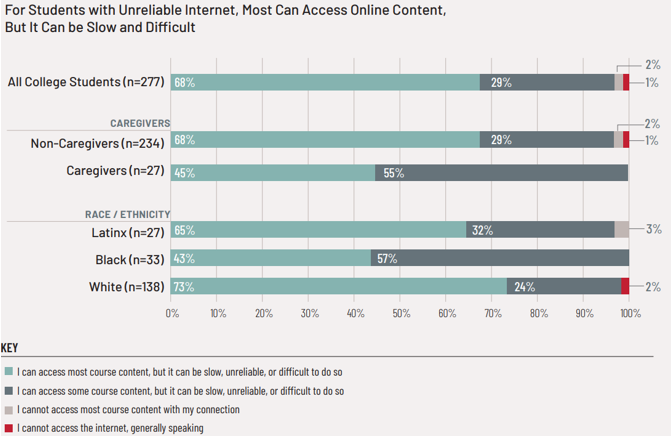 The past year has shown us that technology and internet access are essential to modern-day education. Yet, a May report by the Institute of Higher Education Policy finds that access is not enough. Instead, many students with access often lack reliable internet and share devices with others, hindering their ability to succeed in higher education. Based on polling data collected by New America and Third Way, the study talked to high school seniors and college students to understand their barriers to internet accessibility. It also offers recommendations for institutional leaders and policymakers.
The past year has shown us that technology and internet access are essential to modern-day education. Yet, a May report by the Institute of Higher Education Policy finds that access is not enough. Instead, many students with access often lack reliable internet and share devices with others, hindering their ability to succeed in higher education. Based on polling data collected by New America and Third Way, the study talked to high school seniors and college students to understand their barriers to internet accessibility. It also offers recommendations for institutional leaders and policymakers.
Online Isn’t Optional: Student Polling on Access to Internet and Devices suggests that a lack of reliable internet is not “just an inconvenience for college students,” but an impediment to degree attainment. While online learning was already on the rise prior to the pandemic, it is likely here to stay. However, with unequal internet accessibility and access to suitable devices, online learning may only exacerbate inequalities that already exist.
According to the report, 1 in 4 students overall and 1 in 3 low-income students report sometimes having difficulty connecting to course content because of internet issues. Students who act as caregivers are especially challenged, with 27% reporting they struggled with access to reliable internet. Of the students who had unreliable internet connections, more than half of caregivers and Black students reported they might be able to access some but not all of their course content and that their internet may be slow or have issues.
The study also highlighted the issue that while most students use laptops to complete their coursework, many students rely primarily on a cell phone or tablet. This includes 13% of Black students and 10% of students from low-income households, compared to 8% of all college students. Yet when students use their cell phones or tablets to write essays, watch lectures, and participate in class discussions, they may struggle to engage in their coursework.
Also related to device access, while 3 in 4 of all college students rarely or never report having to share their device that they use to complete coursework, more than half of caregivers and over 35% of Latinx students report sometimes, frequently, or always sharing their device. This means these students may not have their device when needed, potentially hindering course success.
These findings suggest that beyond simply improving broadband access, students need reliable internet and access to adequate devices to utilize technology for their education. Caregivers, students from low-income households, and Black and Latinx students are more likely to report issues like slow or laggy internet, reliance on mobile phones, and the need to share devices with others. Closing this digital divide is paramount for these students to participate fully in postsecondary education in the post-COVID world.
To do so, the report suggests that policymakers acknowledge technology as a postsecondary education necessity and account for it in financial aid/cost of attendance. This may mean adjusting costs of attendance calculations or net price calculators or assessing students’ connectivity expenses when determining students’ financial need.
Further, the report encourages readers to collect and publish more data on student access to reliable internet and technology. More updated and consistent surveys, disaggregated by race and income, would help establish important context around what supports students need and where they may get help. Whether students attend school remotely, on-campus, or in a hybrid format, access to reliable internet and devices to complete coursework is a must. To ensure students can complete their postsecondary programs and be prepared to meet future talent demands, all students—and as this study suggests, especially caregivers, students from low-income backgrounds and Black and Latinx students—need equitable access to stable internet and sufficient devices.
RELATED ARTICLES:

